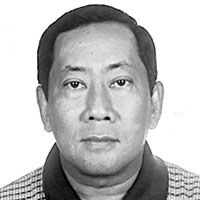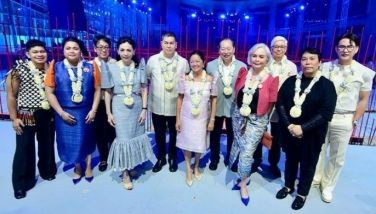US Archives prints story about Cebu incident!

October 12, 2005 | 12:00am
Last June, I was surprised to get an e-mail from Benjamin Guterman, editor/writer of the Product Development Branch of the National Archives and Records Administration (NARA) in the United States, based in Washington D.C. Guterman probably read some of my articles about Lt. Col. James Cushing, the American war hero based in Cebu whose daring exploits have sparked a renewed interest in many people in the United States.
Guterman asked me if I could provide him with photos of the late Col. Cushing and Salvador Abcede, the commander of the Seventh Military District on Negros Island, because the National Archives’ magazine Prologue was coming out with a feature story on Col. Cushing’s exploits in Cebu. Right away, I rang up my uncle, Col. Manuel F. Segura, who promptly sent me black and white photos of his wartime friends. Col. Segura was under Col. Cushing in the Cebu Area Command (CAC). Thanks to Internet technology, I sent those photos to the US Archives and Guterman in time.
The exploits of Col. Cushing were featured in my uncle’s book Tabunan and later in another book he wrote, The Koga Papers, the first time that I know of that the Z-Plan was written about in a book. Recently, American author Steven Trent Smith wrote another book, The Rescue, about 40 American missionaries caught up in Dumaguete by the Second World War; the other half of that book also deals with the Koga Papers (where he generously quoted a lot of items from my uncle’s book) because apparently, the Koga Papers and the American missionaries ended up being rescued by the same submarine, the USS Crevalle, which brought them to the safety of Australia.
Last week, I got another e-mail from Guterman, informing me that the magazine Prologue had already come out, including the photos that I supplied him and he was sending me a copy of it. He also sent me an e-mailed copy of this story written by Greg Bradsher, entitled The Z Plan Story: Japan’s 1944 Naval Battle Strategy Drifts into US Hands. I printed this 12-page article and as a Cebuano, I’m proud to say that finally, an obscure historical incident that happened in Cebu on March 31, 1944 has come out in the US Archives magazine, and therefore, is now officially part of their historical records.
On that fateful day of March 1944, two Kawanishi HSK2 flying boats bearing Admiral Mineichi Koga, commander-in-chief of the Japanese Combined Fleet, the successor of Japan’s famous son, Admiral Isoroku Yamamoto (who was ambushed and shot down by P-38 Lightnings on April 21, 1943), flew from Koror, Palau to Davao City. The other flying boat bore his chief of staff, Admiral Shigeru Fukudome, who personally carried the Z-Plan, which outlined the defense plans of the Japanese Imperial Navy against Allied attacks in the Pacific Theater.
On the way to Davao, 600 miles from Koror, the two Kawanishi flying boats met a violent typhoon and aborted their flight plan, opting to fly to Manila, but instead, they floundered in Cebu. By then, Admiral Koga’s flying boat had vanished, while the other Kawanishi crashed off the town of San Fernando, some 30 kilometers south of Cebu City. There were 12 survivors, who included Admiral Fukudome who was injured in the leg.
The survivors were immediately captured by the guerrillas under the command of Lt. Col. James Cushing and brought to the Cebu Area Command headquarters in Barrio Tabunan, Cebu City, just off the boundary between Cebu City and Balamban. The famous Mt. Manunggal, where President Ramon Magsaysay crashed and met his death, overlooks Barrio Tabunan.
As luck would have it, Col. Cushing kept his prisoners in the mountain fastness of Cebu, while the Japanese military commander in Cebu, Lt. Col. Seiti Ohnishi, frantically searched for the captured Japanese naval officers. Little did Col. Cushing or my uncle, Col. Segura, realize that they had made World War II history… that Admiral Fukudome (actually, Col. Cushing and my uncle thought he was General Foromei) was the highest ranking Japanese official ever captured by the Americans in the Pacific War.
Meanwhile, Pedro Gantuangko, of Perrelos, Carcar, got hold of a floating object, an oil-covered box with a red leather portfolio inside. He didn’t know what it was then, so after drying its wet contents, he sent it to Col. Cushing in Tabunan. Pressure from Col. Ohnishi to surrender his captives became great as the Japanese commander said that he would begin killing Cebuano civilians if he did not surrender his prisoners. Cushing refused and the Japanese commander began killing civilians.
By April 9, 1944, Col. Cushing had no choice but to surrender his captives to Col. Ohnishi so as to stop the killings. After the return of the prisoners, Col. Ohnishi sent a message to Col. Cushing, "I expect to see you again in the battle field someday." True to his word, the Japanese colonel stopped the massacre of civilians and observed a three-day truce with the Cebu guerrillas. Admiral Fukudome left for Manila and eventually arrived back home in Tokyo. This was called the "Otsu incident" by the Japanese high command.
As for the Z-Plan, Col. Cushing got word from Gen. MacArthur that a submarine would be sent to Basay, Negros Oriental to pick up the documents to be brought to Australia. That submarine was the USS Crevalle under the command of Capt. Lt. Comdr. Francis David Walker Jr., who also rescued the American missionaries on the 11th of May. All this was facilitated by Salvador Abcede of the 7th Military District on Negros Island.
All told, the Koga Papers reached Gen. MacArthur’s headquarters in Australia and after deciphering the Z Plan, the allied invasion planned for Sarangani Bay in Southern Mindanao was abandoned and moved up to the lightly defended island of Leyte on Oct. 10, 1944. For too long, authors never talked about, much less mentioned this historical incident that happened here in Cebu 61 years ago. But the truth somehow has surfaced via the books of Col. Segura and Steven Smith and now, no less than the US Archives magazine Prologue has given this story historical prominence. With this, I renew my call to Cebu officials to erect a monument for Col. James Cushing, whose wartime exploits still go unnoticed even in Cebu.
For e-mail responses to this article, write to [email protected]. Bobit Avila’s columns can also be accessed through www.thefreeman.com. He also hosts a weekly talk show, "Straight from the Sky," shown every Monday, at 8 p.m., only in Metro Cebu on Channel 15 of SkyCable.
Guterman asked me if I could provide him with photos of the late Col. Cushing and Salvador Abcede, the commander of the Seventh Military District on Negros Island, because the National Archives’ magazine Prologue was coming out with a feature story on Col. Cushing’s exploits in Cebu. Right away, I rang up my uncle, Col. Manuel F. Segura, who promptly sent me black and white photos of his wartime friends. Col. Segura was under Col. Cushing in the Cebu Area Command (CAC). Thanks to Internet technology, I sent those photos to the US Archives and Guterman in time.
The exploits of Col. Cushing were featured in my uncle’s book Tabunan and later in another book he wrote, The Koga Papers, the first time that I know of that the Z-Plan was written about in a book. Recently, American author Steven Trent Smith wrote another book, The Rescue, about 40 American missionaries caught up in Dumaguete by the Second World War; the other half of that book also deals with the Koga Papers (where he generously quoted a lot of items from my uncle’s book) because apparently, the Koga Papers and the American missionaries ended up being rescued by the same submarine, the USS Crevalle, which brought them to the safety of Australia.
Last week, I got another e-mail from Guterman, informing me that the magazine Prologue had already come out, including the photos that I supplied him and he was sending me a copy of it. He also sent me an e-mailed copy of this story written by Greg Bradsher, entitled The Z Plan Story: Japan’s 1944 Naval Battle Strategy Drifts into US Hands. I printed this 12-page article and as a Cebuano, I’m proud to say that finally, an obscure historical incident that happened in Cebu on March 31, 1944 has come out in the US Archives magazine, and therefore, is now officially part of their historical records.
On that fateful day of March 1944, two Kawanishi HSK2 flying boats bearing Admiral Mineichi Koga, commander-in-chief of the Japanese Combined Fleet, the successor of Japan’s famous son, Admiral Isoroku Yamamoto (who was ambushed and shot down by P-38 Lightnings on April 21, 1943), flew from Koror, Palau to Davao City. The other flying boat bore his chief of staff, Admiral Shigeru Fukudome, who personally carried the Z-Plan, which outlined the defense plans of the Japanese Imperial Navy against Allied attacks in the Pacific Theater.
On the way to Davao, 600 miles from Koror, the two Kawanishi flying boats met a violent typhoon and aborted their flight plan, opting to fly to Manila, but instead, they floundered in Cebu. By then, Admiral Koga’s flying boat had vanished, while the other Kawanishi crashed off the town of San Fernando, some 30 kilometers south of Cebu City. There were 12 survivors, who included Admiral Fukudome who was injured in the leg.
The survivors were immediately captured by the guerrillas under the command of Lt. Col. James Cushing and brought to the Cebu Area Command headquarters in Barrio Tabunan, Cebu City, just off the boundary between Cebu City and Balamban. The famous Mt. Manunggal, where President Ramon Magsaysay crashed and met his death, overlooks Barrio Tabunan.
As luck would have it, Col. Cushing kept his prisoners in the mountain fastness of Cebu, while the Japanese military commander in Cebu, Lt. Col. Seiti Ohnishi, frantically searched for the captured Japanese naval officers. Little did Col. Cushing or my uncle, Col. Segura, realize that they had made World War II history… that Admiral Fukudome (actually, Col. Cushing and my uncle thought he was General Foromei) was the highest ranking Japanese official ever captured by the Americans in the Pacific War.
Meanwhile, Pedro Gantuangko, of Perrelos, Carcar, got hold of a floating object, an oil-covered box with a red leather portfolio inside. He didn’t know what it was then, so after drying its wet contents, he sent it to Col. Cushing in Tabunan. Pressure from Col. Ohnishi to surrender his captives became great as the Japanese commander said that he would begin killing Cebuano civilians if he did not surrender his prisoners. Cushing refused and the Japanese commander began killing civilians.
By April 9, 1944, Col. Cushing had no choice but to surrender his captives to Col. Ohnishi so as to stop the killings. After the return of the prisoners, Col. Ohnishi sent a message to Col. Cushing, "I expect to see you again in the battle field someday." True to his word, the Japanese colonel stopped the massacre of civilians and observed a three-day truce with the Cebu guerrillas. Admiral Fukudome left for Manila and eventually arrived back home in Tokyo. This was called the "Otsu incident" by the Japanese high command.
As for the Z-Plan, Col. Cushing got word from Gen. MacArthur that a submarine would be sent to Basay, Negros Oriental to pick up the documents to be brought to Australia. That submarine was the USS Crevalle under the command of Capt. Lt. Comdr. Francis David Walker Jr., who also rescued the American missionaries on the 11th of May. All this was facilitated by Salvador Abcede of the 7th Military District on Negros Island.
All told, the Koga Papers reached Gen. MacArthur’s headquarters in Australia and after deciphering the Z Plan, the allied invasion planned for Sarangani Bay in Southern Mindanao was abandoned and moved up to the lightly defended island of Leyte on Oct. 10, 1944. For too long, authors never talked about, much less mentioned this historical incident that happened here in Cebu 61 years ago. But the truth somehow has surfaced via the books of Col. Segura and Steven Smith and now, no less than the US Archives magazine Prologue has given this story historical prominence. With this, I renew my call to Cebu officials to erect a monument for Col. James Cushing, whose wartime exploits still go unnoticed even in Cebu.
BrandSpace Articles
<
>
- Latest
- Trending
Trending
Latest
Trending
Latest
Recommended

































